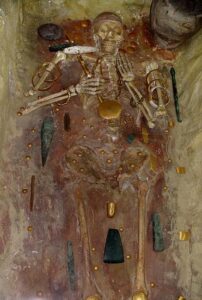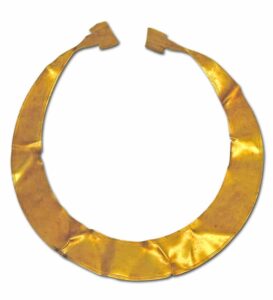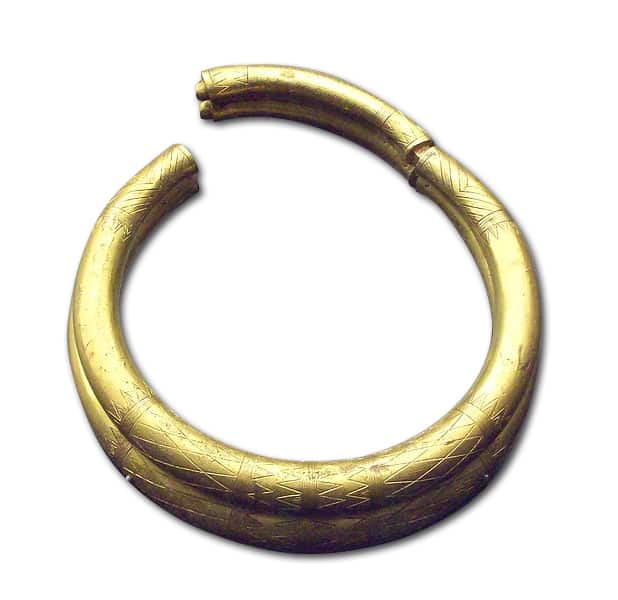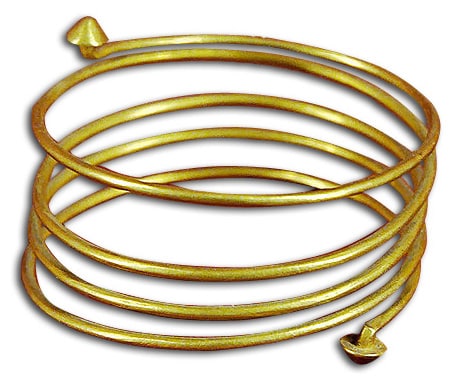Pre-Celtic Europe (4400-1400 BC)
The term ‘Celtic’ is used to describe the inhabitants of Europe during the Iron Age. It is a vast generalisation of tribes that display certain similarities in their language, culture, tools and also: their jewelry. It would be wrong to call the inhabitants of Bronze Age Europe ‘Celts’ as well, more often these cultures are called the Beaker cultures, but for the sake of continuity of styles and because of the similarities in development we will discuss these Bronze Age cultures first in this article. After all, the Celtic styles and techniques are a direct result of this earlier period.
Away from the Mediterranean

Although one might get the impression that all jewelry originates from the ancient Mediterranean world and Asia Minor when reading the articles on Egyptian jewelry, Etruscan jewelry, Greek jewelry and Roman jewelry there was quite a bit of activity north of the Alps in ancient times. In fact, the oldest known gold jewelry was found at Varna, modern-day Bulgaria. The artifacts found at grave sites here are believed to date as far back as 4400 BC! Due to their geographical position away from the Mediterranean, the cultures in northern and central Europe developed an independent style.
Over the course of the Bronze Age, social differences increased and expressing ones high status became more and more important. Personal decoration has been one of the ways to stress these differences and hence we see ‘prestige jewelry’ being found in the graves of chiefs and warlords of early European civilizations. This is something that happened simultaneously in different areas over the whole of Europe during the Bronze Age.

One of these areas was the British Isles which were rich in alluvial gold. Here we can see a strong development over the Bronze Age in jewelry manufacture. Some of the materials used were gold, bronze, amber, jet, and shale. Gold was hammered into sheets and decorated with embossed and chased patterns similar to those found on pottery from that period: zigzag motives, triangles and diamond (kite) shapes. Good examples of early Bronze Age goldwork are the typical lunulae.
The use of copper and later bronze required casting techniques. Bronze isn’t as malleable and ductile as gold. This caused early bronze jewelry to be much simpler of form and with less fine detail. Hammering bronze to a sheet to apply the goldworking technique of repoussé to the item was practiced occasionally though.
Jet was used to make all kinds of ornaments among which were spacer beads and bi-conical beads that were used in strung necklaces. The craftsmanship of carving jet reached extremely high forms and pointillé techniques were used to decorate the product. A fair part of the jet ornaments found on mainland Europe is to believe to have been produced on the British Isles. The same counts for some gold jewelry.
Late Bronze Age (1400-1200 BC)
The long tradition of metalworking laid a strong foundation for the periods to come. By the end of the bronze age, new techniques had been developed such as the casting of gold, wire making, and bar twisting. The improvement in casting techniques caused a shift of focus onto the complexity of the overall shape of an object. More detail is found on cast pieces from the late Bronze Age that were the result of complex clay molds. New materials such as glass were used in beads. Continuation of tradition can be found in the popularity of amber, jet, bronze, and gold and in the use of chasing and repoussé to decorate metalwork.
The types of jewelry from earlier periods comprised mainly body ornaments like neck rings, strung necklaces, bracelets, and earrings which were now joined by clothing and hair decoration. Fibulae became one of the most common forms of jewelry and its manufacture was made possible by the development of gold wire. Basic forms of jewelry are found throughout Europe, local fashion is to be recognized here and there but the general idea was the same. One of those universal forms of jewelry was the neck-ring or torc.
Celtic Europe: The Iron Age (1200 BC – 400 AD)
Iron Age grave sites show us corpses that were fully dressed and ornamented. This allows us to form a detailed picture of jewelry worn in those days. The most widespread type of jewelry was the safety pin used to fix clothing: the fibula. Most commonly made from bronze but also found in iron, silver and gold this garment fastener is found in large numbers. Finger and toe rings were rare, more common were bronze and some gold and silver bracelets and cast bronze solid armlets, cast with the lost wax technique and decorated with enamel and glass. Red enamel in particular popular among the Celts. Torcs are another typical ornament found in Celtic graves, mainly female ones. This item developed from a plain iron ring to elaborately decorated neck rings in gold.



Roman influences are seen long before the Roman conquest of the Celtic lands but after the defeat of the Celtic armies in the first century BC and the Roman march to the Rhine and British Isles had begun the full ‘romanization’ of the Celts was a fact. The Celtic ‘high society’ started to act, dress and talk like Romans and the latest trends from the Empire’s capital made it all the way up to Northern Europe. Finger rings, chain necklaces, and earrings were new forms of jewelry in these parts of the world up until then and became popular items. New materials such as gemstones and silver were introduced as well. But it wasn’t all new though, certain typical Celtic characteristics are still to be recognized in jewelry from the first quarter of the first millennium such as the use of enamel and typical Celtic knot motives. Old styles fused with new ones to produce a Gallo-roman style.
Modern Use of the Term ‘Celtic Jewelry
The term is also used for jewelry using ornate knots and whiplash Celtic motifs, a revival of which is seen in the English Victorian Scottish jewelry and later Arts and Crafts jewelry.
Sources
- Naturalis Historia, Gaius Plinius Secundus, 79AD
- 7000 Years of Jewellery, Various Authors, edited by Hugh Tait, British Museum Press, London, 1986.
- Ancient Jewellery: Interpreting the Past, Ogden, Jack, British Museum Press, London, 1992.
- Jewelry, from Antiquity to the Present, Phillips, Clare, Thames & Hudson, London, 1996.